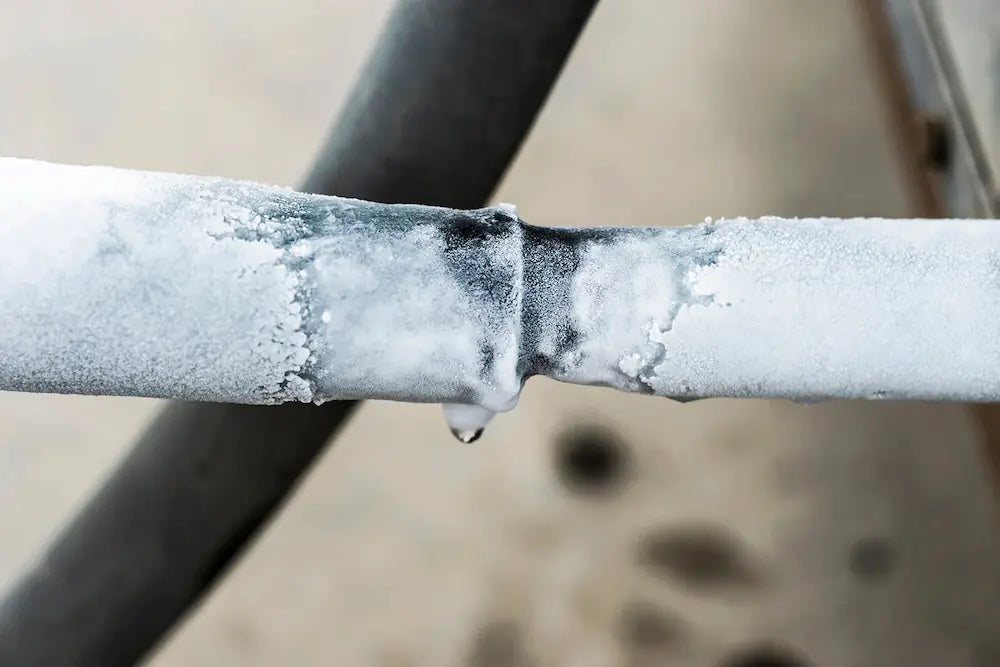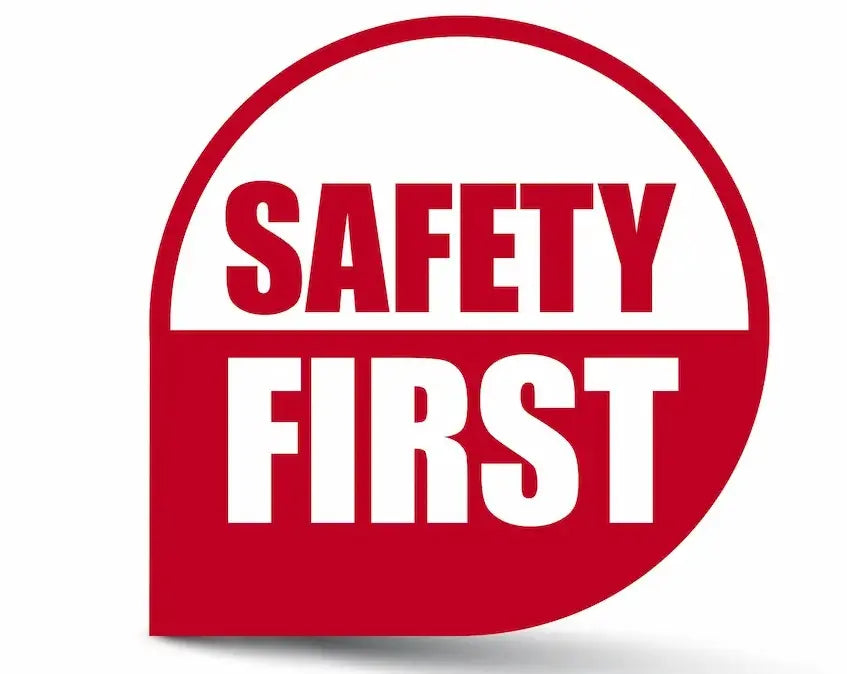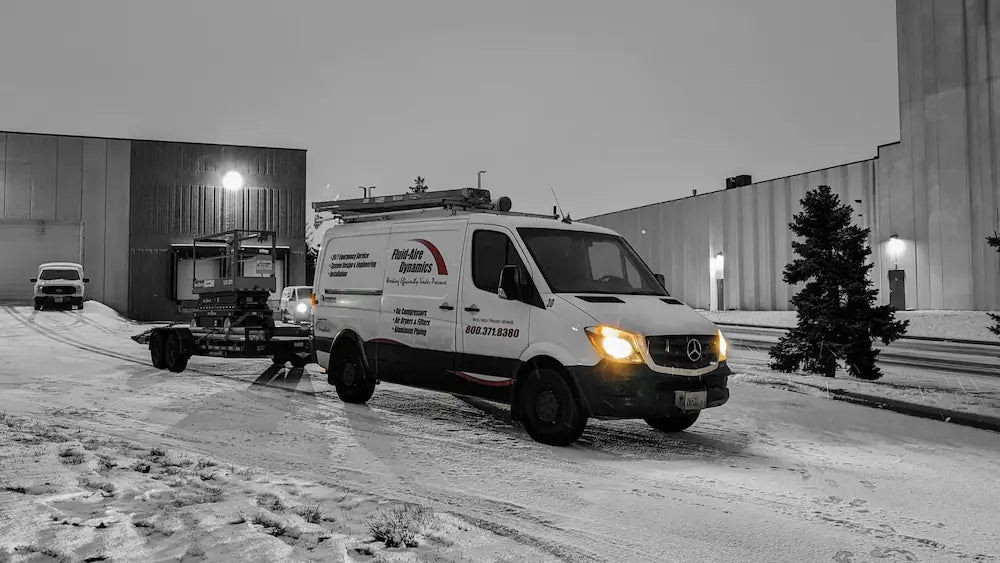
How do freezing winter temperatures affect compressor operation and compressed air system maintenance? Low ambient temperatures can have adverse effects on your industrial air compressor, air dryer, and compressed air system accessories. Here's what you need to know about maintaining your air compressor in cold weather along with other system components. If winter weather has your system down, Fluid-Aire Dynamics is here to help with urgent air compressor repairs!
Air Compressors in Cold Weather
Most compressed air systems are designed to operate in temperatures above 40° degrees Fahrenheit. In the winter months, if your system is not in a heated indoor environment, ambient air temperatures may drop below freezing. When this happens, your compressed air system may sustain both short-term and long-lasting damage.
This happens because compressed air systems generate condensate, which can freeze — clogging, or even cracking vulnerable air compressor components, such as condensate drains. Furthermore, as the air cools below 32° degrees Fahrenheit, it can lead to frozen air compressor control lines, frozen or cracked heat exchangers, frozen drain valves, and other types of damage to air compressors and air dryers.
Low temperatures have several effects on your air compressor.
Air Compressor Oil
Air compressor oil becomes thicker as temperatures drop. This reduces its lubrication capabilities, thereby increasing the power needed to operate the compressor pump. This results in higher motor amp draw and increased strain on the whole drive train. Over time, this will reduce the lifetime of your air compressor's motor.
Air Compressor Control Lines

Control lines accumulate moisture from condensate during normal operation of the compressed air system. In cold temperatures, air compressor control lines can quickly freeze up, with adverse effects on system performance.
Rotary Screw Air Compressors
If your rotary screw air compressor won't start in the winter, cold ambient temperatures are likely to blame. Rotary screw air compressors are often equipped with a low ambient temperature sensor and switch (fault), which prevents the system from starting if ambient temperatures are below 40°F.
Note: If the air compressor is already running, it will most likely continue to run, because the compressor will generate enough of its own heat to keep it above freezing temperatures. However, this does not mean that the cold is not impacting other parts of the system.
Air Dryers in Cold Weather
In cold ambient conditions, refrigerated air dryers may operate too efficiently. As moisture is separated out by the dryer, it can be cooled to a point where it will freeze within the heat exchanger, causing blockages or damage.
Heat Exchanger
If moisture freezes inside the heat exchanger, it will not only create a block in the system, but it will probably also crack the heat exchanger as well.
Drain Valve
The drain valve on refrigerated air dryers may freeze open or shut in cold conditions. This may not create a blockage of the hot air flowing through the dryer, but it will block liquid water from draining through the condensate drain. In these conditions, the moisture cannot escape, and the dryer becomes ineffective.
Desiccant Air Dryers
With desiccant air dryers, wet inlet air can freeze inside the piping, causing a blockage in the control lines that prevents the tower switching valves from functioning. The discharge air purge mufflers may also freeze up, restricting or stopping the purge airflow. This will decrease the drying capacity of the dryer.
Compressed Air Accessories and Other Compressed Air Systems Components in Cold Weather
All compressed air system components are vulnerable to damage in cold weather because of the way that condensate moves through the system. Frozen condensate can cause air or water blockages in air compressor accessories and receiver tanks. If enough ice builds up, it will expand and cause permanent damage to the component or, in the worst case, a tank explosion.
Air compression system components are also more vulnerable to corrosion in cold weather. Because dryers are less efficient in the cold, moisture can build up and remain inside the system for longer than normal. Even if this moisture does not freeze, it can cause components to rust over time.
Drain Valves
As water freezes inside the drain valve, it can lead to cracking. Auto drain valves should be checked frequently for obstructions.
Compressed Air Filter
Ice in the filter will cause a restriction, preventing efficient airflow. When the ice melts, the blockage will be freed. However, ice buildup can fracture the filter bowl and cause major pressure reductions in the plant.
Air Compressor Regulator
Freezing of the air compressor regulator can cause compromised production machine performance due to pressure swings.
Cold Weather Air Compressor Maintenance Tips
Damage to your compressed air system due to cold ambient temperatures can be expensive to repair and lead to unplanned shutdowns of your operations in the winter months. However, most of these impacts can be avoided with proper cold-weather preventative maintenance for your air compressor, air dryer, and accessories.
Weatherproofing Your Air Compressor Room
One solution is to prevent ambient temperatures around your air compressor system from dropping below 40°F by utilizing heaters or proper ventilation methods in the compressor room. This also may involve weatherproofing the area where your compressed air system is installed. The compressor room does not need to be heated to the same levels needed for human comfort. However, maintaining temperatures around 45°F will go a long way towards keeping your air compression system in running order during the winter.

Note: Safety first! If considering a portable or temporary heating source, make sure that its installation and operation will not create a fire hazard in the area in which it is installed. Consult your HVAC provider for guidance on your heating options.
Cold-Proofing Your Air Compression System
If the area where your air compressor is installed cannot be easily kept above 40°F, you can take steps to cold-proof the system itself. These steps may include:
- Install and use a low ambient air temperature limit switch (if available for your air compressor model). This will prevent permanent damage to the system from running in cold temperatures.
- Install trace heating around pipes to prevent freezing and condensation. Trace heating for pipes can prevent ice obstructions and help your dryers work more efficiently.
- Have your air compressor fitted with an internal sump heater to keep temperatures above 40°F.
- Add appropriate insulation for pipes and other system components to reduce the risk of freezing.
Note: Low ambient temperature options will vary by system type and model. Check with your air compression system provider for details. Some options may make your system more difficult to maintain and repair. Refrigerated dryers generally do not have low ambient temperature options.
Cold-Weather Preventative Maintenance for Air Compression Systems
When running your system in cold weather, you need to take some extra steps to protect your air compressor, air dryer, and components.
- Check the air compressor and components daily for moisture and ice buildup. Pipes and components far from the air compressor motor can be especially vulnerable to icing.
- Check the auto drain system daily for icing and obstructions. If you do not have an auto drain valve, manually drain condensate from the system more often at least once daily.
- Check oil levels frequently. Your system works harder in the winter and may use more oil. In some cases, you may want to change to a lighter weight winter-grade oil in colder weather. Check the owner's manual for your system or contact your manufacturer for guidance.
- Check compressed air filters frequently for icing and blockage. Change filters if they become iced over.
Restarting a Frozen Air Compressor
Even with cold weather preventative maintenance, a severe or extended cold snap may result in a frozen air compression system. Here's how to get things restarted.
- Shut off all external fresh outside air sources.
- If it is an enclosed unit, remove or open the doors/panels of the compressor.
- Turn up or add a heat source to the room or area to get the ambient temperatures above 45°F.
- Add a heat source to the bottom of the sump tank until the compressor oil is warmed to 70°F.
- Once the compressor is warmed to a temperature above the set limit (40°F to 45°F), you may need to reset the alarm on the control panel. After this, the air compressor should be good to start.
- Once the compressor is running, inspect closely for leaks.
- Inspect all condensate drain valves.
Need Cold-Weather Air Compressor Repair or Maintenance?

Maintaining the optimal performance of your air compressors during the freezing winter months requires vigilance, preventive measures, and regular checks. Understanding how freezing temperatures affect various components ensures a proactive approach, minimizing downtimes and costly repairs. At Fluid-Aire Dynamics, we're dedicated to ensuring your compressed air system runs smoothly year-round. If you need advice on cold weather preventative maintenance or are searching for air compressor repair services and parts, our team is here to assist. Contact us today!
